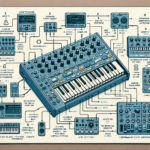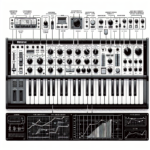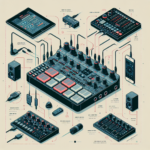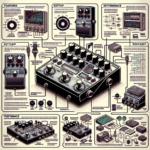ROLI Seaboard Block: Comprehensive Guide to Features, Setup, and Performance
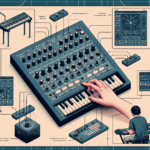
Introduction
The ROLI Seaboard Block is a revolutionary MIDI controller designed to offer musicians and producers an unprecedented level of expressive control. Unlike traditional MIDI keyboards, the Seaboard Block features a soft, pressure-sensitive surface that allows for a wide range of gestures, including slides, presses, and lifts, making it a versatile tool for both studio and live performance settings. Targeted at both beginners and professionals, this controller aims to bridge the gap between traditional keyboard playing and modern electronic music production.
ROLI, the brand behind the Seaboard Block, has built a strong reputation in the music technology industry for its innovative and high-quality products. Known for pushing the boundaries of what MIDI controllers can do, ROLI has garnered a loyal following among musicians and producers alike.
Key Features Overview:
- Pressure-sensitive, soft-touch surface
- Five dimensions of touch: strike, glide, slide, press, and lift
- Compact and portable design
- Wireless connectivity via Bluetooth
- Customizable MIDI mapping
- Integration with popular DAWs
Design and Build Quality
Physical Design
The ROLI Seaboard Block is compact and sleek, measuring approximately 11 x 5.5 inches and weighing just under 1 pound. The surface is made of a soft, silicone-like material that is both durable and responsive to touch. The overall design is minimalist, with a focus on functionality and ease of use.
Portability
One of the standout features of the Seaboard Block is its portability. Its compact size and lightweight design make it easy to transport, whether you’re heading to a studio session or a live performance. The wireless Bluetooth connectivity further enhances its portability, allowing you to use it without the need for cumbersome cables.
Durability
Despite its lightweight design, the Seaboard Block is built to withstand regular use. The soft-touch surface is resistant to wear and tear, and the overall build quality is robust. Users have reported that the controller holds up well even after extended periods of use, making it a reliable choice for both studio and live environments.
Setup and Configuration
Initial Setup
Setting up the ROLI Seaboard Block is straightforward. Follow these steps to get started:
- Unbox the Seaboard Block and ensure it is fully charged.
- Turn on the Seaboard Block by pressing the power button.
- Connect the Seaboard Block to your computer via USB or Bluetooth.
- Open your DAW or music software and select the Seaboard Block as your MIDI input device.
Software Installation
To fully utilize the Seaboard Block, you will need to install the ROLI Dashboard software. This software allows you to customize the controller’s settings and update its firmware. Follow these steps to install the software:
- Visit the ROLI website and download the ROLI Dashboard software.
- Run the installer and follow the on-screen instructions.
- Once installed, open the ROLI Dashboard and connect your Seaboard Block.
- Follow any prompts to update the firmware and configure your settings.
Compatibility
The ROLI Seaboard Block is compatible with a wide range of operating systems and DAWs. Supported operating systems include Windows 10 and macOS 10.12 or later. The controller integrates seamlessly with popular DAWs such as Ableton Live, FL Studio, Logic Pro, and GarageBand. Additionally, it can be used with other music software that supports MIDI input.
Features and Functionality
Key Features
The Seaboard Block offers a range of features that set it apart from traditional MIDI controllers:
- Pressure-sensitive surface: The soft-touch surface responds to various gestures, allowing for expressive playing.
- Five dimensions of touch: The controller recognizes strike, glide, slide, press, and lift gestures, providing a wide range of expressive possibilities.
- Wireless connectivity: The Seaboard Block can connect to your computer or mobile device via Bluetooth, reducing cable clutter.
- Customizable MIDI mapping: Users can assign different functions to the controller’s surface, tailoring it to their specific needs.
Customizability
The ROLI Dashboard software allows users to customize the Seaboard Block’s settings to suit their preferences. You can adjust the sensitivity of the touch surface, assign different MIDI functions to various gestures, and create custom presets for different applications. This level of customization makes the Seaboard Block a versatile tool for a wide range of musical styles and workflows.
Unique Functions
One of the unique features of the Seaboard Block is its ability to recognize five dimensions of touch. This allows for a level of expressiveness that is not possible with traditional MIDI controllers. For example, you can slide your finger along the surface to create pitch bends, press harder to increase volume or modulation, and lift your finger to trigger different effects. These capabilities make the Seaboard Block a powerful tool for creating dynamic and expressive performances.
Integration with DAWs
The Seaboard Block integrates seamlessly with popular DAWs, allowing you to use it as a MIDI controller for your music production software. In Ableton Live, for example, you can use the Seaboard Block to control virtual instruments, trigger clips, and manipulate effects. In Logic Pro, you can use it to play software instruments and record MIDI data. The controller’s customizable MIDI mapping makes it easy to tailor its functionality to your specific workflow.
Advanced Features
The Seaboard Block also offers a range of advanced features that enhance its functionality. These include aftertouch, which allows you to add expressive modulation to your playing by pressing harder on the surface, and an arpeggiator, which can be used to create complex rhythmic patterns. Additionally, the controller includes chord modes that allow you to play chords with a single finger, making it easier to create harmonically rich performances.
Performance
Latency and Responsiveness
The Seaboard Block is designed to offer low latency and high responsiveness, making it suitable for both studio and live performance settings. Users have reported that the controller’s touch surface is highly responsive, with minimal latency even when using wireless Bluetooth connectivity. This ensures that your gestures are accurately translated into MIDI data, allowing for precise and expressive playing.
Real-World Usage
In practical scenarios, the Seaboard Block performs exceptionally well. In a studio setting, it can be used to create expressive performances and record MIDI data with a high degree of accuracy. In live performances, its portability and wireless connectivity make it a convenient and versatile tool. Musicians have praised its ability to add a new level of expressiveness to their playing, making it a valuable addition to their setup.
User Experience
Overall, users have reported a positive experience with the Seaboard Block. Many have praised its innovative design and expressive capabilities, noting that it offers a level of control that is not possible with traditional MIDI controllers. Some users have mentioned a learning curve when first using the controller, but most agree that it is well worth the effort. The ROLI Dashboard software has also received positive feedback for its ease of use and customization options.
Applications and Use Cases
Beginner vs. Professional Use
The Seaboard Block is suitable for both beginners and professionals. Beginners will appreciate its intuitive design and ease of use, while professionals will benefit from its advanced features and customization options. The controller’s expressive capabilities make it a valuable tool for musicians of all skill levels.
Studio Use
In a studio environment, the Seaboard Block can be used for music production, recording, and sound design. Its expressive touch surface allows for dynamic performances, and its customizable MIDI mapping makes it easy to integrate into your existing workflow. Whether you’re creating electronic music, scoring for film, or producing pop tracks, the Seaboard Block offers a range of possibilities.
Live Performance
The Seaboard Block is also well-suited for live performances. Its compact size and wireless connectivity make it easy to transport and set up, and its expressive touch surface allows for dynamic and engaging performances. Musicians have used the Seaboard Block in a variety of live settings, from solo performances to full band setups.
Specific Genres
The Seaboard Block excels in a wide range of musical genres. Its expressive capabilities make it particularly well-suited for electronic music, where it can be used to create intricate soundscapes and dynamic performances. It is also popular among hip-hop producers for its ability to add expressive modulation to beats and melodies. Additionally, classical musicians have used the Seaboard Block to add a new level of expressiveness to their performances.
Pros and Cons
Pros:
- Innovative and expressive touch surface
- Compact and portable design
- Wireless Bluetooth connectivity
- Customizable MIDI mapping
- Seamless integration with popular DAWs
- Advanced features such as aftertouch and arpeggiator
Cons:
- Learning curve for new users
- Higher price point compared to traditional MIDI controllers
- Limited number of keys compared to full-sized keyboards
Common Issues and Troubleshooting
Known Issues
Some users have reported issues with Bluetooth connectivity, particularly when using the controller in environments with a lot of wireless interference. Additionally, there have been occasional reports of the touch surface becoming less responsive over time.
Troubleshooting Tips
If you experience issues with Bluetooth connectivity, try moving to a different location or using a USB connection instead. If the touch surface becomes less responsive, try cleaning it with a soft, damp cloth. Additionally, make sure that your firmware and software are up to date, as updates often include bug fixes and performance improvements.
Customer Support
ROLI offers a range of customer support options for the Seaboard Block. Their website includes a comprehensive support section with FAQs, user guides, and troubleshooting tips. Additionally, users can contact ROLI’s customer support team via email or live chat for further assistance. Overall, users have reported positive experiences with ROLI’s customer support, noting that their issues were resolved quickly and efficiently.
Comparisons with Similar Controllers
Competitor Comparison
When compared to similar controllers from other brands, the Seaboard Block stands out for its innovative touch surface and expressive capabilities. While traditional MIDI keyboards such as the Akai MPK Mini and Novation Launchkey offer a range of features, they do not provide the same level of expressiveness as the Seaboard Block. Additionally, the Seaboard Block’s compact size and wireless connectivity make it a more portable option.
Feature Comparison
In terms of features, the Seaboard Block offers a range of advanced capabilities that set it apart from its competitors. Its five dimensions of touch, customizable MIDI mapping, and advanced features such as aftertouch and arpeggiator make it a versatile and powerful tool. While it may have a higher price point compared to some traditional MIDI controllers, its unique features and expressive capabilities make it a worthwhile investment for serious musicians and producers.
Conclusion
Summary
The ROLI Seaboard Block is a revolutionary MIDI controller that offers a level of expressiveness and versatility that is unmatched by traditional keyboards. Its innovative touch surface, advanced features, and seamless integration with popular DAWs make it a valuable tool for both studio and live performance settings.
Who Should Buy This?
The Seaboard Block is suitable for musicians and producers of all skill levels. Beginners will appreciate its intuitive design and ease of use, while professionals will benefit from its advanced features and customization options. Whether you’re creating electronic music, scoring for film, or performing live, the Seaboard Block offers a range of possibilities.
Final Thoughts
Overall, the ROLI Seaboard Block is a game-changer in the world of MIDI controllers. Its innovative design and expressive capabilities make it a valuable addition to any musician’s toolkit. While it may have a higher price point compared to traditional MIDI controllers, its unique features and versatility make it a worthwhile investment for serious musicians and producers.
FAQ
What is the ROLI Seaboard Block?
The ROLI Seaboard Block is a MIDI controller with a pressure-sensitive touch surface that allows for expressive playing. It offers five dimensions of touch: strike, glide, slide, press, and lift.
Is the Seaboard Block suitable for beginners?
Yes, the Seaboard Block is suitable for beginners. Its intuitive design and ease of use make it a great choice for those new to MIDI controllers.
What DAWs are compatible with the Seaboard Block?
The Seaboard Block is compatible with a wide range of DAWs, including Ableton Live, FL Studio, Logic Pro, and GarageBand.
Can I use the Seaboard Block wirelessly?
Yes, the Seaboard Block can connect to your computer or mobile device via Bluetooth, allowing for wireless use.
How do I customize the Seaboard Block’s settings?
You can customize the Seaboard Block’s settings using the ROLI Dashboard software. This software allows you to adjust the sensitivity of the touch surface, assign different MIDI functions to various gestures, and create custom presets.
Where to Buy
The ROLI Seaboard Block can be purchased from a variety of retailers, including major music stores such as Guitar Center, Sweetwater, and Sam Ash. It is also available from online retailers such as Amazon and directly from the ROLI website.

